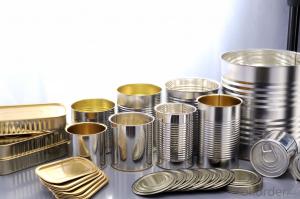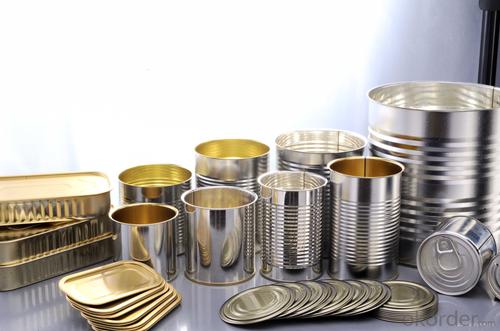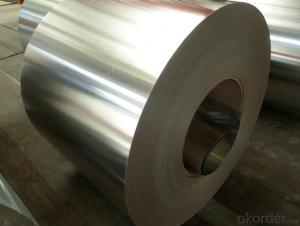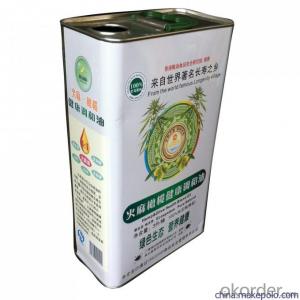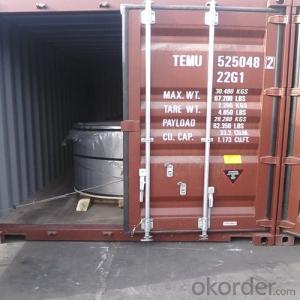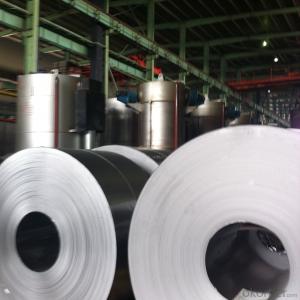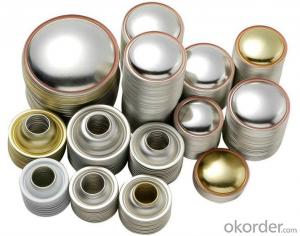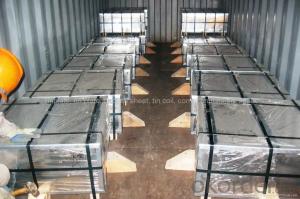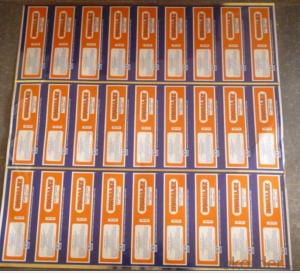Prime Tinplate For Paint Cans, SPCC Material
- Loading Port:
- China main port
- Payment Terms:
- TT OR LC
- Min Order Qty:
- 25 m.t
- Supply Capability:
- 40000 m.t/month
OKorder Service Pledge
OKorder Financial Service
You Might Also Like
Specification
1.Usage
Tinplate is widely used for making all types of containers, containing industrial usage such as paint can, oil can, aerosol cans etc., and food cans like milk powder cans, tomato paste can, dry food cans etc.
2. Quality
As a state owned company and a large tinplate supplier in China, our tinplate quality ranks 1st level in China, similar to Bao Steel, Posco etc.
3. CA Line Production Range
Temper | Thickness(mm) | Width(mm) | Length(mm) |
T3CA | 0.19~0.20 | 800~900 | 520~1068 |
0.21~0.25 | 800~950 | ||
0.26~0.45 | 800~1050 | ||
T4CA | 0.17~0.20 | 800~950 | |
0.20~0.45 | 800~1050 | ||
T5CA | 0.17~0.20 | 800~950 | |
0.20~0.28 | 800~1050 |
4. Our factory photo & equipments

4. Our Overseas Wareouses:
we are having and will built more than 10 overseas warehouses all over the word, located in KSA, UAE, Oman, Russia, Kuwait, Qatar, Oman, Chile, Brazil etc.
5. FAQ
a. what's the annual output?
about 500,000 tons per year.
b. where's the raw matrial from?
our hot rolled coil is purchased from Capital Steel and other state owned mill, with quite good quality.
c. how long is the delivery time?
normally for SPCC about 45~55 days, while 65~75 days for MR material
d. how to control the quality during production process?
inside our workshop, we have MES syestem. It realizes the optimization of the production procedure in the workshop. It could record each step of the whole production procedures, and if some problem appears, factory could easily found and take action, it’s quite helpful to monitor and control the quality.
- Q: Can tinplate be used for packaging liquid products?
- Yes, tinplate can be used for packaging liquid products. Tinplate is a type of steel coated with a thin layer of tin, which provides excellent barrier properties against moisture and oxygen. This makes it suitable for packaging liquids as it helps to prevent spoilage and maintain the product's quality. Additionally, tinplate is also durable and safe for food contact, making it a popular choice for packaging various liquid products such as beverages, oils, and sauces.
- Q: What are the main applications of tinplate in the tobacco industry?
- The main applications of tinplate in the tobacco industry include the production of cigarette packaging, such as cigarette boxes and tins. Tinplate offers excellent protection against moisture, light, and air, helping to preserve the quality and freshness of tobacco products. Additionally, tinplate's durability and malleability make it ideal for creating intricate designs and embossing, enhancing the aesthetic appeal of tobacco packaging.
- Q: Can tinplate be used for packaging of sensitive electronic components?
- Yes, tinplate can be used for packaging of sensitive electronic components. Tinplate is known for its excellent barrier properties, providing protection against moisture, oxygen, and other external factors that could potentially damage electronic components. Additionally, tinplate is lightweight, easily formable, and cost-effective, making it an ideal choice for packaging sensitive electronic components.
- Q: What are the advantages of using tinplate for automotive components?
- Tinplate offers several advantages for automotive components. Firstly, it is highly corrosion-resistant, which helps protect the components from rusting and extends their lifespan. Additionally, tinplate is strong and durable, providing excellent structural integrity to the automotive parts. It is also lightweight, contributing to fuel efficiency and reducing the overall weight of the vehicle. Moreover, tinplate is easily formable and can be shaped into complex designs, allowing for greater design flexibility in automotive components. Lastly, tinplate is a sustainable material as it is 100% recyclable, making it an eco-friendly choice for the automotive industry.
- Q: Tin can weldingHow can the side of the column of the pop top be welded or pressed?,
- The cans are divided into two cans and three cans of two. Two piece cans by punching a stamping molding, the iron material, equipment and technology requirements are high, so at present only a few large companies have the production capacity of three cans. Relatively the requirements will be relatively low,
- Q: Can tinplate be used for packaging pet food?
- Yes, tinplate can be used for packaging pet food. Tinplate is a common material used in the food industry due to its durability, corrosion resistance, and ability to preserve the quality and freshness of the packaged product. It is suitable for packaging pet food as it provides a protective barrier, keeps the food safe from external contaminants, and ensures a longer shelf life.
- Q: Can tinplate packaging be used for gardening products?
- Yes, tinplate packaging can be used for gardening products. Tinplate is a durable and corrosion-resistant material that can protect gardening products from moisture, sunlight, and other external elements. It is commonly used for packaging seeds, fertilizers, gardening tools, and other related products.
- Q: What are the main markets for tinplate?
- The main markets for tinplate include the packaging industry, particularly for canned food and beverages, as well as the automotive industry for various components. Tinplate is also used in the construction sector for roofing and cladding purposes.
- Q: How is tinplate corrosion resistant?
- Tinplate is corrosion resistant due to the protective layer of tin that is electroplated onto the surface of the steel. This tin layer acts as a barrier, preventing oxygen and moisture from coming into direct contact with the steel, thereby reducing the risk of corrosion.
- Q: How does tinplate perform in terms of durability and longevity?
- Tinplate is known for its exceptional durability and longevity. The tin coating provides excellent corrosion resistance, preventing the metal underneath from rusting or deteriorating. This makes tinplate highly suitable for packaging purposes, as it can protect the contents for an extended period. Additionally, tinplate's sturdy construction ensures it can withstand mechanical stress and maintain its integrity over time, further enhancing its durability and longevity.
Send your message to us
Prime Tinplate For Paint Cans, SPCC Material
- Loading Port:
- China main port
- Payment Terms:
- TT OR LC
- Min Order Qty:
- 25 m.t
- Supply Capability:
- 40000 m.t/month
OKorder Service Pledge
OKorder Financial Service
Similar products
Hot products
Hot Searches
Related keywords
